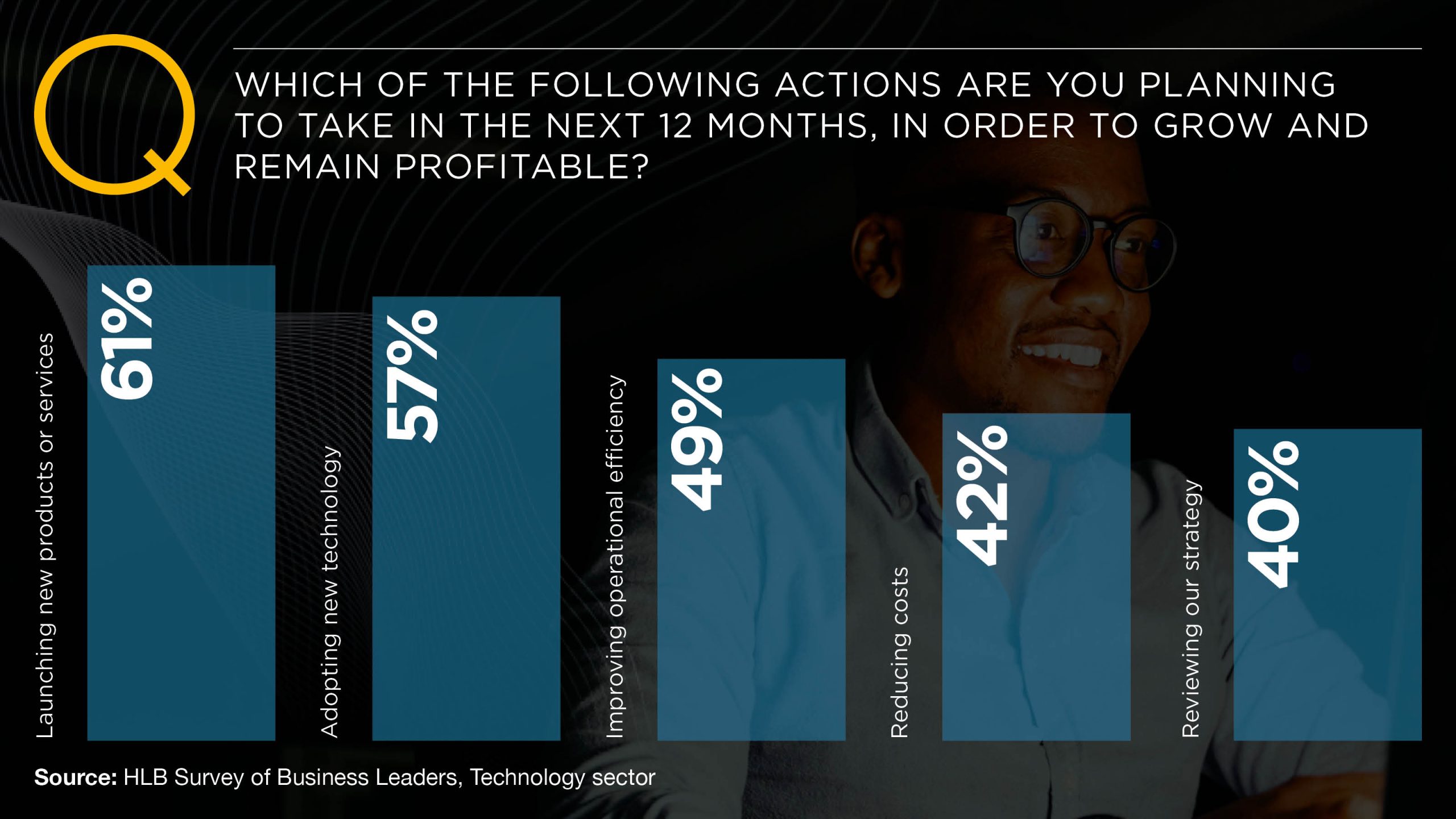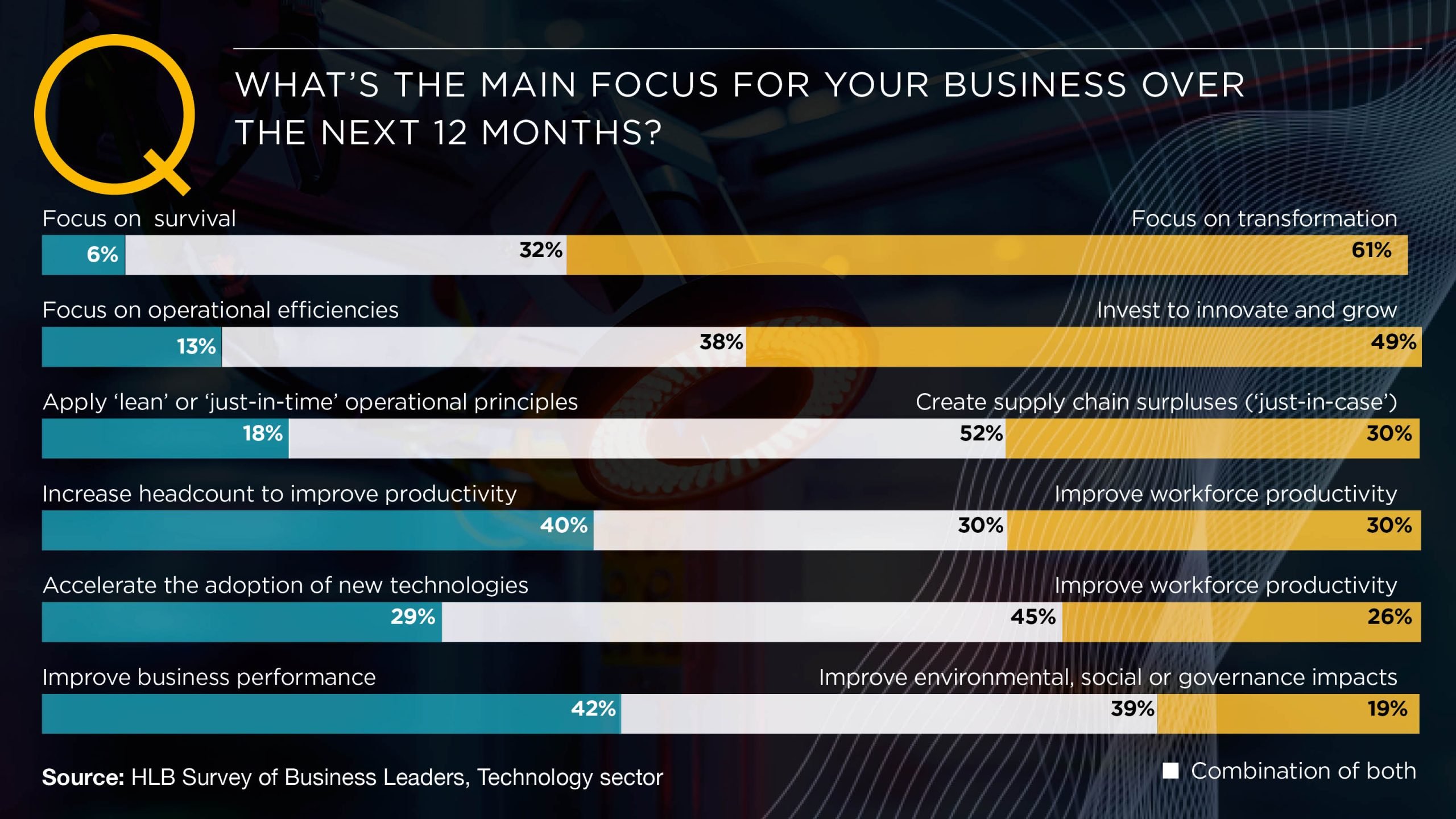Embrace technology for a brighter future
Technology Sector Outlook - HLB Survey of Business Leaders 2023Key Insights from the technology sector:
- 86% of the technology sector are confident about their company’s ability to grow revenue over the next 12 months with 61% planning to launch new products and services to remain profitable and grow.
- Cloud (73%), AI (57%), and machine learning (40%) are the most important technologies for the sector over the next 5 years.
- 58% of leaders in the sector are simultaneously improving business performance and its environmental, social, and governance (ESG) impacts.
Technological advancement has been a constant since the industrial revolution, yet recent decades have seen technology evolve at a seemingly exponential rate. This was certainly true at the turn of the century, yet by the 2010s that ever-growing pace was finally matched by clear direction. Leading through a perfect storm: The HLB Survey of Business Leaders 2023 shows that we have indeed entered an era of democratic, transformational, and technology-led leadership, offering a healthy balance of visionary encouragement and delegation.
As we stand in 2023 we are on the cusp of fully embracing the era of web3, and are already enjoying huge advancements in Artificial Intelligence (AI), virtual reality, and the metaverse. Moving forward, technology will be key to economic growth to an unprecedented extent.
The Survey of Business Leaders 2023 found that having an efficient workforce is crucial for achieving the ambitious priorities leaders have set for this year, while the adoption of new technology adoption will play a crucial role. In terms of juggling priorities, over 70% of business leaders are focusing on accelerating the adoption of new technologies. Technology and technological advancement is no longer seen as a tool for transformation but a necessity of survival. Over the next five years our respondents are anticipating AI, cloud computing, and renewable energy technologies to play the most significant roles in business. Moreover, it’s no longer just about digital technology as renewable energy, battery technologies and biometrics are also figuring highly.
Below we look at the technology sector and how keeping on top of technological advances will ensure your business can weather the storm over the coming years.
Looking towards the next 5 years…

Economic expectations are greatly muted this year with 45% of the technology sector expecting global growth to decline in 2023. Given the events of 2022 in the wake of the COVID pandemic and the face of an uncertain situation in Ukraine, it’s perhaps unsurprising that 82% of respondents felt acutely concerned about the impacts of inflation. Indeed, 81% from the technology sector are concerned about inflation, which was identified as the top risk to the sector.
That being said, 86% of the technology sector are confident in their company’s ability to grow revenue over the next 12 months, with 61% planning to launch new products and services to remain profitable and grow.
New technology adoption was the third growth priority at 45%. Business leaders in the technology sector identified cloud (73%), AI (57%), and machine learning (40%) as the most important technologies for their businesses over the next 5 years.
While technology has been viewed as a potential threat in the past, business leaders today are embracing the possibilities it brings and the potential of partnership. Employees are now working hand in hand with technologies to be as efficient as possible, while using technology to create solutions in combination that neither could achieve on their own.
Having an efficient workforce is crucial for achieving the ambitious priorities leaders have set for this year, which include:
- Operational efficiency improvements
- New technology adoption
- New product launches
Overall, in the Survey of Business Leaders 2023, talent was selected by 35% of leaders as the highest weakness they need to focus on over the next 12 months. Meanwhile, 40% of leaders in the technology sector felt the top weakness was the acquisition of talent, rather than talent itself. 70% are concerned about their access to talent in the sector over the next 12 months.
Following on from talent acquisition as a core concern that the technology sector needs to focus on over the coming 12 months was operation effectiveness (39%) and innovation (27%). Our 2023 survey found that global businesses now face eight major risks, including cybersecurity issues, which was identified as a concern by 60% of respondents. In the technology industry, 67% are concerned or very concerned about cyber security, while 65% of the sector believes the risks of cybersecurity will increase in the next 5 years.
Survival mode
With complex socio-political issues to navigate alongside technological development and change, leaders need to be looking for creative ways to ‘fulfil two needs with one deed’. This will require overcoming today’s crisis by conserving resources where possible, and investing in strategic areas of interest to ensure success in the future.

This is reflected in the plans of 55% of the technology sector to focus on long-term priorities to survive, while 42% are adapting a combination of short-term and long-term activities to grow and prosper. Moreover, 38% of leaders in the technology sector are simultaneously seeking operational efficiencies and investments to innovate and grow. At the same time, 49% are solely focusing on investing to grow over the long-term.
Critically, 70% of the technology industry are evolving their human resource model to meet the requirements for the future of work for their long-term business strategy.
Leading the way
So, what are the essential leadership attributes to lead us through tough times?
Flexibility was the highest ranking ‘essential behaviour’ for successful leadership in a crisis. It was also seen as the highest essential leadership behaviour in the technology sector, with 42% pointing to flexibility as a vital trait. This is more than just a surface concern, however, as respondents indicated that flexibility in strategy has to further translate to lower-level action in critical areas such as talent acquisition, digital capabilities improvement, and supply chain management. To minimise the ongoing impacts of disruption, 52% of leaders surveyed globally apply ‘just in time’ and ‘just in case’ principles to supply chain management. In the technology sector, 82% are applying ‘just in case’ to supply chain surpluses.
If you accelerate the adoption of new technologies, you improve workforce productivity. 45% of technology business leaders surveyed plan to focus equally on accelerating new technology adoption and improving workforce productivity. Having an efficient workforce is crucial for achieving the ambitious priorities leaders have set for this year and new technology adaptation is key to this.
Employers in business services, healthcare, real estate, technology, and transportation, as well as the logistics sectors, in particular, struggle to recruit the right people. Agile thinking further extends to talent management. 40% of leaders in the technology industry are hoping to increase headcount to improve profitability.
Second highest on the list of leadership traits in the technology sector was compelling communication, with 35%.Increasingly, businesses are orienting their mission beyond financial performance.
75% of the tech industry have a clearly defined communicated purpose of their business.
It is evident that leaders need a clearly defined purpose which multiplies the opportunities for attracting the right people, whether they be customers, employees, or shareholders.
A clear purpose is central to how you’re arranging your business. When companies are driven by clearly defined values, the returns will follow. Purpose is the beacon that guides new product development efforts, facilitates expansion into new market verticals, and ensures high returns on investment.
At 34%, integrity was seen as the third highest essential leadership behaviour. During turbulent times, leaders regularly face integrity-based choices. The decision to do the right thing is not always easy, but it sends a powerful signal to your people, corporate stakeholders, and the public at large, showing that your company can be trusted, and, therefore, worthy of ongoing support.
Adopting ESG
Every storm runs out of rain. Looking beyond today’s challenges, we asked business leaders about their purpose beyond financial performance and where they are on their ESG journey.
51% of the technology sector think climate risks will increase in the next 5 years, while 40% agree they are making progress on the journey to becoming carbon neutral in 5 years. We found that 58% of leaders in the technology sector are simultaneously improving business performance and its environmental, social, and governance (ESG) impacts. Yet, 42% are focused on business performance improvements alone.
40% of the technology sector try to meet stakeholder ESG expectations. Given the current energy crisis, there is more room for rapid growth in the the sustainable sectors to grow faster as businesses that use cutting edge technology are better equipped to adopt and grow and overcome the challenges of the next 12 months.
Big technology firms like Google and Microsoft are already investing in on-site clean energy production facilities and other carbon reduction strategies. However, as leaders implement such technologies they will also need to think about offsetting their carbon footprint. With growth driving factors headed up by new product launches at 61% leaders in the technology sector are anticipating positive growth and chance in the next 12 months. It is, however, important to bear in mind that crises not only change the business or market dynamics; they also affect consumer behaviours.
How HLB can help
With so many technological advancements and so much economic uncertainty on the horizon and so many changes in the works, many businesses in the tech industry are looking to each other for the additional support, infrastructure and talent needed. Mergers and acquisitions provide great opportunities for rapid growth and diversification, however, they are not without their challenges. HLB and our team of experts are here to support you every step of the way through 2023.
Sector outlooks

Learn more about our research





